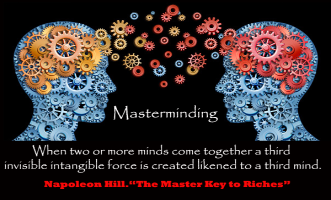We all have two selves at least. Maybe we all have more. LOL. Many say we have a conscious mind and a sub conscious. Some say we have a higher self. Eckhart Tolle says we have a witness type self inside us that sees, hears and feels our thoughts and feelings separate from them actually.
We often will say to ourselves things like “That was a silly thing to do Mike” as if it’s a different person witnessing and commenting on what I, or we, did. I see that second witness self as a higher power. Something that helps us rise above our persona. Our persona is that person we put out there for the world to see. And many of us show different people depending on whom we are interacting with. That’s why I say we have many selves. We might have one for family, one for work people, one for church people, one for kids, one for friends, etc. But we all also have a higher self that gives us higher power. One that sees who we really are in all situations. One that can help us move through any situation with ease when we access it correctly.
The first step to getting in touch with our higher power is through awareness. It’s the beginning of the process that changes our life. Start your awareness by looking at what are you truly thinking and feeling and most important, intending. Be honest with what you’re seeing about who you are. Own it and feel it for a moment and then do the next step.
The second step to changing things is to rise above and see ourselves as a separate person. Move into that higher level of awareness. Be the separate higher person or higher awareness. Once there, sit for a moment in the NOW and in the awareness of these true thoughts, emotions and intentions you are witnessing.
If they are negative, own them as your struggling self that has desire to change. If they are positive feel some gratitude and build on your positive self. We have all been told about the power of positive thought, emotion and intention — it’s all true. Every great thinker and great achiever in the world will tell you to be positive, to think big, to dream, to set goals, to feel positive and to intend positive — to stay positive as you move through struggle and stick it out, even when its uncomfortable and negative.
To be dynamic and move through change with some ease, take the second step and separate from your negative thoughts and feelings as you notice them. Rise above and see them as a third self. Rise above with your higher self and say to yourself that you can change them and you are beginning to do it NOW.
The third step is preparation for when you are feeling negative. Build a positive self that you can refer to when you notice the negative. Start now and do it whenever you think of it. Get in touch with some positive aspect of yourself. Gratitude is often one of the easiest processes used in shifting negative to positive. What can you be grateful for right now? If you need a boost in gratitude, watch this 10 minute video by Louie Schwartzberg on Gratitude. It s the best one I’ve seen on the topic so far. (Watch Video)
Think about your strengths. What good things have people told you about you? Put those characteristics in your positive self. Think of your accomplishments. Think of your goals and dreams—put them in your positive self.
Create a safe cave inside yourself to keep this positive person you want to be in. Bring in light and create the self you want to be in that cave. See that person. Let this positive person inside you evolve and continue to build on it every time you feel grateful, get a compliment or achieve something. The Lemurians did it. They would go into a cave and act the person they wanted to be, no matter what was going on in the real world, outside the cave.
Step four is accessing the cave and this person the next time you are feeling negative. Practice whenever you think of it and develop the habit. Every time you feel negative, rise above the situation and look down on it. Then look into the cave and invoke the positive you to replace the negative you. The more you do it, the quicker the habit will develop. Start practicing now. Start building that positive self and the safe cave inside you now. Then practice bringing him or her out whenever you think of it. Practicing is what life is all about. We are all practicing. Doctors and lawyers say it and do it all the time.
Use your higher power to rise above into awareness and look down on your negative self, own it and embrace it, and then access the positive cave man or woman and be him or her. You can do it. We all can and it will make the world around us a better place.
Watch the FindAMentor people tune up video series to get a path to you higher self and follow it. Read the FindAMentor 12 Simple Tricks to Success blog post series. Do whatever it takes to get you back on your winning journey. Each one of us started our life here on Earth as a winner. Each one of us beat out millions of others to fertilize that egg inside our mothers. Each one of us is a one in a million winner. Get back in touch with your higher self and back on that winning journey. Join our FindAMentor Gold Club and get some life coaching from me in monthly webinars.
Enjoy the journey. Enjoy your higher self and higher power. Use it to be the person you want. Thanks for reading.
Mike Garska,
FindAMentor.com










 Daily Inspirational Email Sign Up
Daily Inspirational Email Sign Up